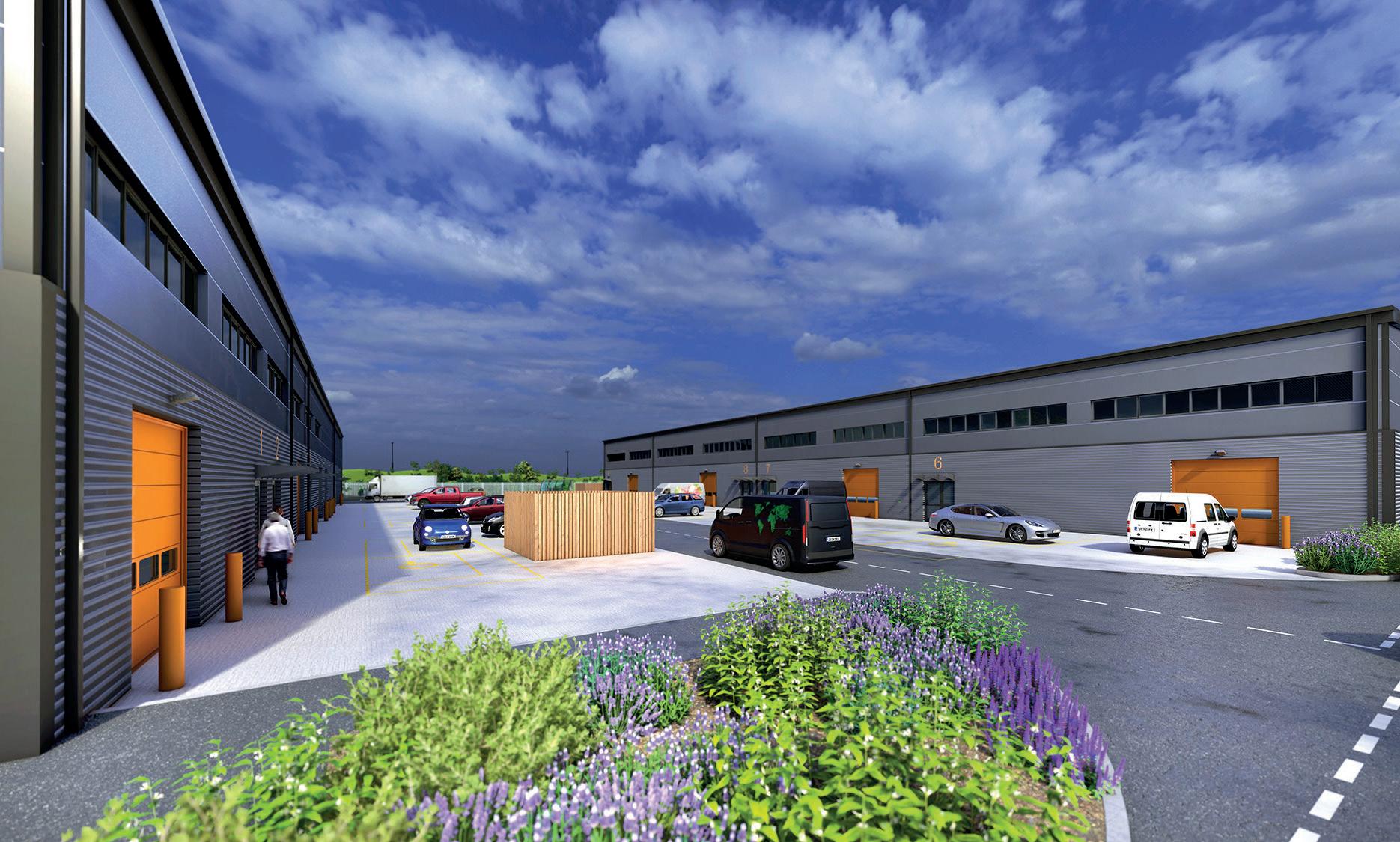
8 minute read
REGIONAL PROPERTY OUTLOOK
Office space – flexible working still changing working habits
The o ce market is tougher where – unlike the industrial logistics market – there is a healthy supply pool, according to Thames Valley property agents Neil Seager and Alec White of Haslams.
"The activity is mainly lease event driven as occupiers grapple with flexible working brought about by the pandemic. ESG (environmental, social, and corporate governance) and wellness are now higher up a check list for occupiers which has resulted in the predicted flight to prime. Fitted solutions are also now very much part of the mainstream.
"Several large corporates are rumoured to be in the market to include Wood, Visa and Lonza. Where these requirements land will provide a steer as to where the market is heading.
"The secondary o ce market remains the most challenging. We are seeing a number of these o ces put up for sale by investors. As a result, we expect the gap between prime and secondary o ces to widen.”
In the Midlands, o ce spaces of up to 2,500 sq ft are performing extremely well, driven by the UK’s strong community of start-up firms, as well as established businesses seeking to upscale without committing to long-term leases, according to Peter Holt, director at Holt Commercial.
"Organisations are more hesitant to commit to larger o ce premises – a hangover from the pandemic as well as a response to economic uncertainty – as they are unsure of their future wants and needs.
"The need for properties to meet minimum energy e cient standards by 2030 means that any deals on larger premises are likely to be for modern, Breem-excellent premises.”
Tom Bromwich, founding partner of Bromwich Hardy, says the o ce sector has defied the critics who predicted its collapse in the wake of the pandemic and the rise of home and hybrid working.


"That has not happened, and we are currently seeing strong demand for accommodation in Leamington, Warwick and Coventry city centres in particular.
“However, there has been a very noticeable flight to quality since the pandemic," says Peter.
"Businesses know that they need to give employees a good reason to return to the workplace and investment in high-quality, sustainable, modern o ce space is key to that. The Bourn development in Coventry is an excellent example of this.
“As a result, we have seen a significant rise in interest in o ces of 20,000 sq ft or more and a general increase in accommodation over 5,000 sq ft.
And rental growth for o ce space in Bristol was the highest of any of the Big Six cities outside London in 2022, according to commercial property firm JLL.
Its research tracks o ce take-up, vacancy rates and grade A rental growth across
Birmingham, Bristol, Edinburgh, Glasgow, Leeds and Manchester.
It found year-on-year rental growth in Bristol stood at 10.4 per cent in 2022, with headline prime rents reaching £42.50 per sq ft.
Across the year, 116 deals were completed in the city, taking it to its highest level since 2016 and leaving only 3.9 per cent of o ces available to rent. The largest deal to complete in 2022 was Paymentsense’s prelet of 54,767 sq ft at EQ, followed by Pax8 acquiring 24,375 sq ft at The Distillery.
Simon Peacock, head of South West at JLL, said: “It’s not hard to see why demand outstrips supply in Bristol – fantastic universities, a thriving business community and a booming residential market make it an attractive place to study, work and live.

“But the city needs greater investment in transport and our city planners so we can bring prosperity to all our people – not to mention that a more stable political and economic climate will attract the capital needed to boost Bristol’s long-term growth prospects.”
Retail – a slow return
The dormancy of the retail property market felt during the pandemic has finally abated, say Neil Seager and Alec White.
"This recovery has been tapered by the cost-of-living crisis as households tighten their belts.
"E-commerce has flatlined at around 38 per cent of the total retail sales which while still large, provides a fillip to the high street.
"There has been a noticeable upturn in demand. This includes an expanding fast-food o er and planned expansions of existing high street brands to include Dune, Mango, Primark, Asda Express and Monsoon."
Online shopping has meant big names are occupying fewer shops – with large out of town retailers now rarely taking units in excess of 30,000 sq ft, says Peter Holt.
"Smaller retail spaces of up to 3,000 sq ft are experiencing strong demand because of their ability to be converted quickly to other uses, such as a restaurant or gym, without the need for planning permission.
"This flexibility is likely to continue to fuel mixed use retail spaces."
Independent retail continues to hold up well throughout the region, though the general economic climate is far from ideal, says Tom Bromwich.

"Clearly there has been some consolidation among some of the big High Street players and we expect this to continue.
“But in the wake of this, there have also been good examples of large town and city centre premises being repurposed successfully, such as the conversion of House of Fraser in Leamington to o ces and Ikea Coventry’s successful transformation to a cultural and arts centre."
Industrial & logistics –occupier demand for high quality remains high
"There is no doubt the second half of 2022 was a di cult period for the sector," says James Davies, CEO of The Wigley Group.

"Rising interest rates and inflation meant transactions reduced as both buyers and sellers stagnated.
"Speculative development declined due to the price paid on land in the peak, as well as material costs and labour. This has ultimately led to a significant supplydemand imbalance.
"Despite the challenging financial and economic backdrop creating uncertainty for business, there has been optimism since Christmas and the sector suggests being in a better place. Markets are starting to predict and understand where the interest rates may peak, which was 4.5 per cent in March.
"Because of the clarity, you are starting to see transactions begin to come back. Appetite for leasing high-quality industrial space remains high. In occupational terms, our own vacancy rates are low and they have not dropped below the high 90 per cent mark for some time now. We were at 100 per cent only six months ago.
"The sector is well-placed to move forward and so are we. We have just secured planning consent for two industrial schemes that we are looking to deliver in the next 12-18 months in the heartland of the industrial epicentre, the Midlands.

"Both Endemere Road and Rowley Drive schemes in Coventry react to a need in the market for smaller units of varying sizes, rather than large single units, and we are looking forward to delivering those for the region’s businesses for 2024."
Tom Bromwich said: "The situation remains fundamentally sound in the industrial and logistics market despite yields being hit by the ill-fated Liz Truss mini-Budget, and the lack of new development being particularly keenly felt here.”
“It is true to say that yields are now starting to stabilise as confidence returns –something Jeremy Hunt’s recent ‘steadyas-you-go’ Budget helped – and that occupier demand continues to push rents up.
“Here, we need to see flexibility and imagination from local authorities and planners to free up su cient employment land, and not just rely on two or three bigticket schemes filling their quotas as has happened in the past.”
Peter Holt said: "Twelve months ago we were seeing larger units being taken up before they were even built, but now we are starting to see more brand new units, and second-hand ones, remaining on the market,"
"The value of development land is also decreasing – mainly due to rising interest rates. Overall, supply still cannot keep up with demand, but this could level o by the end of this year.”
In the Thames Valley, the industrial and logistics market remains robust, but will be hampered by a lack of supply of suitable premises, says James Newton, surveyor at property consultancy, Vail Williams.
“Occupier demand for high-quality industrial and logistics premises boasting a good range of green credentials will remain, but so too will restricted supply. This, together with rising build costs and lower yields, is likely to push rents on further this year as landlords seek to deliver meaningful stock to answer demand.
“Yield movement and build costs will bring into question development viability, reducing confidence in speculative development. However, those developers and landlords delivering new or refurbished highquality stock to market will see it snapped up, if they are brave enough to build on spec – such is the level of occupier demand.
“This represents a great opportunity for landlords to achieve a good return on investment in the industrial market – our experience on the ground with occupiers, tells us that if you build it they will come.
“This also creates the chance to deliver high-quality new or refurbished stock with greener specifications and ESG credentials – something which is vital amid changing energy performance certificate (EPC) rating requirements which, from April 1, will see commercial properties with EPC ratings of E or below deemed ‘substandard’ and unlettable.
“By 2027, the EPC standard will become a C and by 2030, a B –working towards the UK net zero strategy by 2050.”
Science & technology needs space to grow
Cell and gene therapy (CGT) is changing the face of healthcare, and 67 per cent of Oxford lab floorspace was taken CGT companies in 2022, says Rob Beatson, head of o ce agency at Bidwells, Oxford.


"With the market set to grow from $5 billion in 2020 to a staggering $58 billion in 2026, the real estate implications are hard to ignore.
"Specialisms across the life science sector all have their own specific requirements, but the CGT sphere is particularly challenging.
"Businesses in this sector have unique needs when it comes to location. Proximity to clinicians, the CGT research ecosystem, and hospitals with specific expertise is essential for research and development.
"Manufacturing facilities are equally demanding in terms of location due to the need to maintain the integrity of the products in advance of patient treatment.
"By understanding and catering to the needs of CGT businesses, they can tap into a growing market that's transforming healthcare and creating a new type of demand.
"Specialised facilities, such as cleanrooms and laboratories, are necessary to meet regulatory requirements and ensure the safe development of therapies and the transportation of patient materials requires specialised conditions, making the choice of location critical. Being located near a hospital with very specific expertise is essential.
"Moderna's decision to locate its facility at Harwell highlights the importance of the experience and knowledge held within the local ecosystem. This strategic move showcases the importance of global standing clusters and their potential to attract keystone companies.
"The firm’s arrival in Oxfordshire will now attract other businesses keen to colocate with the global giants in the way that AstraZeneca's arrival in Cambridge attracted other fast-growing UK research businesses to the Cambridge Biomedical Campus.
"By understanding and addressing the unique needs of CGT businesses, investors and developers can tap into a growing market that's transforming healthcare and the future of Life Sciences real estate."
Peter Holt adds: "There is a big drive for the region to facilitate growth in these sectors, which we are already seeing with gaming in Leamington and the UK Battery Industrialisation Centre, but there needs to be a renewed focus on homegrown manufacturing in order for demand to take o in the future."








